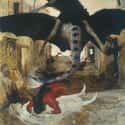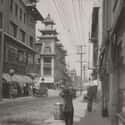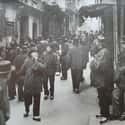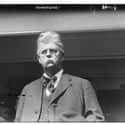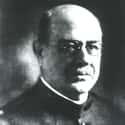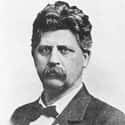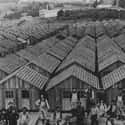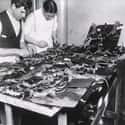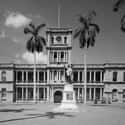-
(#1) The San Francisco Plague Was The First Major Plague Outbreak In The Continental US
Though the San Francisco plague was hardly the first major illness that residents of the continental US had to address, it was the first major outbreak of the plague. The illness — named the Black Plague or the Black Death when it ravaged Europe in the 1300s and caused some 50 million deaths — made a comeback in the 1800s, seriously affecting China and much of east Asia.
Because of global trade and increasing numbers of people emigrating and immigrating worldwide, it was only a matter of time before epidemics began to spread. However, people did not yet understand exactly how the disease was transmitted — many believed it spread through open wounds, food, or the "miasma" theory, which claimed that diseases like the plague spread through "bad air." Because of these conflicting, erroneous theories, the world wasn't prepared to respond to a wide-scale epidemic.
-
(#2) The First San Francisco Plague Victim Was A Chinese Immigrant
The first person to die in the San Francisco plague was Wong Chut King, a lumber salesman and Chinese immigrant who was found unconscious in the flophouse where he lived after suffering an intense fever. In a morbidly preemptive move, he was brought to a nearby coffin shop where he died.
Examination of his body revealed swollen lymph nodes — called buboes, hence the disease's name — consistent with a plague infection, as well as an insect bite. Flea transmission was not yet a popular theory to explain plague infection, so while it was noted, the report did nothing to quell the subsequently rampant xenophobic explanations for the disease. When microscopic investigation revealed plague bacteria in Wong Chut King's blood, Chinatown was quarantined to stop the spread, though the fleas and rats that carried the disease were not hindered by arbitrary barriers.
-
(#3) The Outbreak Centered On San Francisco's Chinatown District
San Francisco's plague outbreak was concentrated in the Chinatown district, just a few blocks from what is now the Port of San Francisco. Because Chinatown was particularly overpopulated, had poor sanitation, and had many people living in poor conditions, those features were blamed for the outbreak rather than the actual cause: flea-ridden rats brought from plague-stricken China on the ships that came to the harbor. Instead of treating the cause, the city quarantined its Chinese residents.
But quarantines don't stop rats, and the disease continued to spread outside of the quarantined zones. Because conditions were poor, and racism was rampant, the quarantined residents didn't get proper medical treatment. Thus, the concentration of infected people, fleas, and rats could grow, leading to even more infections.
-
(#4) Rats From China Probably Carried The Plague To America On Ships
In the late 1800s and early 1900s, scientists and medical professionals weren't yet sure what caused the plague. The miasma theory, which suggested the disease was spread through "bad air," was popular, as were suggestions that the plague might travel through contaminated food or open wounds. The bubonic plague is actually transmitted via flea bite, with the carrier fleas often living on rats.
China was dealing with a plague outbreak of its own in the mid-late 1850s, which soon made its way to Hong Kong. Since Chinese immigrants and imports commonly made the journey to San Francisco, it was only a matter of time before the plague reached American soil.
-
(#5) Racism Was Undoubtedly A Factor In The Plague's Outbreak
The plague itself was a problem, but anti-immigrant sentiment and racism against Chinese people exacerbated the issue. Around this same time, the Chinese Exclusion Act, which prevented Chinese people who were not merchants from immigrating to the US, was extended. Rampant, unfounded anti-Chinese sentiment promoted racist policy, which in turn validated racist viewpoints because of state-sanctioned rules.
In the initial quarantine, white people in Chinatown were told to leave while Chinese residents were forced to stay. Miasma theory, which posited the disease was spread via contact with contaminated air, was blamed for the plague in Chinatown.
Rather than the poor sanitation being a symptom of the area's poverty, it was instead said to be evidence that the Chinese people themselves were the problem. Some went so far as to claim that a rice-based diet made them susceptible to the plague.
-
(#6) San Francisco's Governor Denied The Outbreak Out Of Fear It Would Hurt The City's Reputation
One of the biggest stumbling blocks to stopping the plague's initial four-year hold on San Francisco was the city government. The governor, Henry Gage, actively denied the city had a problem, fearing it would hurt tourism and trade. Worse, he didn't just deny the problem — he actively thwarted efforts to stop it. Gage claimed funds were being diverted to stop a plague that didn't exist. He also suggested Dr. Joseph J. Kinyoun, who led the quarantine effort, had fabricated or caused the plague himself by injecting Chinese residents with the disease.
Though there was little help available for victims, Gage's denial — as well as his active attempts to stoke tension between Kinyoun's efforts and the Chinese people whose civil rights were being violated — ensured the plague continued to ravage the city's ostracized citizens.
-
(#7) The City Ran A Defamation Campaign Against The Officer Who Discovered The Outbreak
Dr. Joseph James Kinyoun was the leader of the plague eradication movement, but, due to both concentrated misinformation efforts and lack of scientific information, his plans to stop the plague were thwarted. Kinyoun was unsure how to curtail the plague's spread, and he ineffectively quarantined Chinatown in the hopes that it would keep the infection isolated. When animals were infected with the disease and didn't immediately die, the quarantine was lifted, and the city government, particularly Governor Henry Gage, seized on it as proof that Kinyoun had no idea what he was doing. He warned that shipments of goods could spread the illness out of San Francisco and around the country, leading to other states refusing to accept goods from California.
Gage responded to the lost profits by claiming Kinyoun himself had created the plague by injecting Chinese corpses. Furthermore, he stoked the flames of the poor treatment Chinese people were receiving by encouraging them to fight back. Combined with Kinyoun's reportedly uptight demeanor, which did not mesh well with the Chinese population he was meant to be helping, his efforts were undercut, and he was eventually transferred. The plague raged on until Dr. Rupert Blue replaced Kinyoun and shifted the treatment from quarantine to pest eradication.
-
(#8) Governor Gage's Denial Helped Seal His Loss In The Elections
Governor Gage's actions were not without consequences. Anti-Chinese sentiment, along with the tensions that arose from the quarantine and Gage's efforts to create a divide between health officials and Chinese residents most threatened by the outbreak, meant that people hid the deceased bodies of plague victims, furthering the infectious spread. People continued to get sick and die, and not just in Chinatown.
Though the disease was concentrated in the slums, it wasn't thwarted by barbed-wire quarantines. As it became increasingly clear that the illness was real, the citizens of San Francisco realized Gage's denial and shifting of the blame to Dr. Joseph Kinyoun were actively hurting people. The state's conservative party refused his nomination, and Gage left office in 1903. He continued to blame Kinyoun for the barring of California goods in other states and the subsequent economic hardship.
The next governor, George Pardee, shared Gage's concerns regarding public address of the situation but immediately took ownership of the situation. He removed health officials from the case and worked privately to provide medical attention, research, and eradication of the plague.
-

(#9) Some Of The City's Treatments Actually Spread The Disease Further
Because the plague was not well understood, many of the treatments San Francisco health officials initially used to combat the illness actually made things worse. The quarantine, the first line of defense when the plague's initial victim was found, concentrated the Chinese-American population in an area with poor sanitation and did nothing for the actual cause of the plague — the rats that were drawn there precisely because of the poor sanitation. The city also used carbolic acid in an attempt to rid the air of the alleged miasma, which drove rats out of sewers and into the streets carrying their plague-riddle fleas with them.
In addition, because relations between the Chinese people of San Francisco and the health officials were so poor, people in Chinatown started hiding the bodies of the deceased. Without proper disposal, the health crisis worsened. Nobody knew that the disease was mostly transmitted through flea bites, thus, nobody was doing anything to stop the spread. All of these factors combined to make the plague even worse.
-
(#10) Another Outbreak Occurred After The 1906 Earthquake
The first plague outbreak occurred from 1900 to 1904, but it wasn't the last to affect San Francisco in the early 1900s. A second outbreak occurred in 1906 following the enormous San Francisco earthquake, which killed some 3,000 people and displaced 250,000 more. But people weren't the only ones displaced.
As humans fled their damaged homes, so did infected rats. As they spread, the chaos of the post-earthquake city and the concentration of people in refugee camps meant that the illness was allowed to spread once again. This outbreak was even stronger than the first, but it was more quickly contained thanks to scientific advancements between 1904 and 1906.
-
(#11) The Second Outbreak Was Dealt With Far More Efficiently
While the second outbreak of plague hit San Francisco just two short years after the first one, it was handled much more quickly. Scientific advancements meant people better understood the plague's transmission, and instead of quarantining infected people, Dr. Joseph Kinyoun's replacement, Dr. Rupert Blue, targeted the rats. They were rounded up in great rat-catching efforts thanks to financial bounties, which ultimately prevented some of the spread and allowed scientists to test and kill infected rats.
Not only was the threat identified before the plague's second time around, but the city government also could no longer scapegoat the Chinese residents of the city: all the victims of the second plague were white. Though anti-Chinese sentiment was still prominent, the blame couldn't be shifted — it wasn't miasma, diet, or any xenophobic cause, which meant it had to be dealt with scientifically and medically.
-
(#12) 119 People Died In The First Outbreak
119 people died during the San Francisco plague outbreak, many of them in the concentrated, quarantined region of Chinatown. Without access to health professionals and pest control, infected victims spread the plague inadvertently but rapidly. Although it's certainly a deadly disease, the city's failure to isolate the actual cause and treat infected people ensured its spread and ability to affect more people.
Though it's not the absolute deadliest outbreak in US history — the introduction of smallpox by European settlers killed almost all indigenous people in what is now North America, for example — the San Francisco plague is one that could have been prevented or had its harm minimized if those in authority had taken action.
Instead, it was allowed to fester in the city's most impoverished communities, sowing further anti-Chinese sentiment.
-
(#13) Honolulu's Chinatown Burned To The Ground When Authorities Attempted To Eradicate The Plague
The plague resurfaced in China on the backs of rats in the 1850s and wound up in Hong Kong. Chinese immigrants and imports often passed this way en route to San Franciso via port stopovers in Hawaii. Following one ship's stop in Hawaii in 1899, a case of the plague broke out in the Honolulu Chinatown, spreading quickly to four more people. In an attempt to contain the plague and eradicate the conditions fostering its rapid spread, The Hawaii Board of Health isolated the victims and quarantined 14 blocks of the area complete with military guards. According to historical record, "To clear contaminated areas, the Board set 41 controlled fires, cleaned and disinfected buildings, burned garbage, filled old cesspools and dug new ones."
However, when this failed to quell the problem and new cases of the plague arose, the Board set another fire which quickly spun out of control and resulted in all of Honolulu's Chinatown burning to the ground. The problematic ships nonetheless continued to San Francisco where, because people on the ships did not show plague symptoms, they were allowed to dock. Along with humans also disembarked infected rats, carrying the disease straight into the port city.
New Random Displays Display All By Ranking
About This Tool
The bubonic plague is one of the most deadly disasters in human history. From the 14th century until the early 19th century, the bubonic plague ravaged Europe and killed about a quarter of the population. In the early 20th century, the disease spread to San Francisco, although the US government attached great importance to the infectious disease, the plague in San Francisco was more lethal than it should have been.
The doctors fabricated that the disease would only appear in Asians and that whites would not be infected. Finally, the plague spread to all of San Francisco. The U.S. government still refused to recognize the outbreak of the plague. The random tool introduced 13 details about the outbreak of the bubonic plague in San Francisco in the 1900s.
Our data comes from Ranker, If you want to participate in the ranking of items displayed on this page, please click here.











